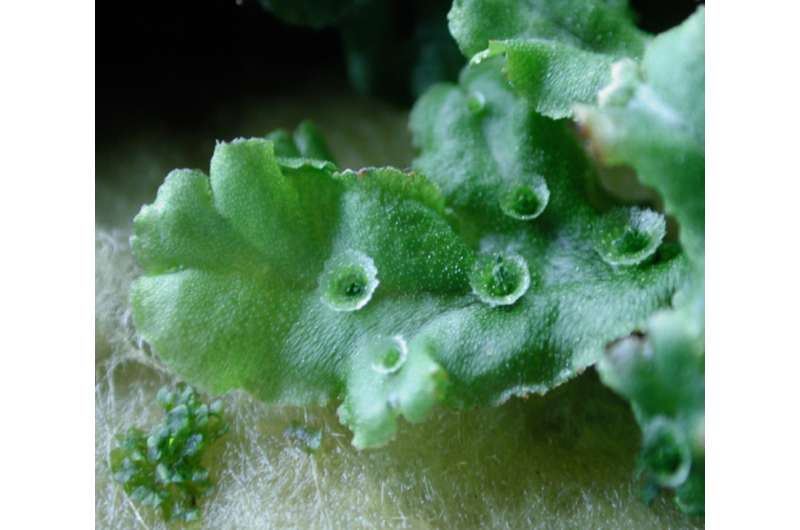Genome analysis of early plant lineage sheds light on how plants learned to thrive on land

Though it's found around the world, it's easy to overlook the common liverwort - the plant can fit in the palm of one's hand and appears to be comprised of flat, overlapping leaves. Despite their unprepossessing appearance, these plants without roots or vascular tissues for nutrient transport are living links to the transition from the algae that found its way out of the ocean to the established multitude of land plants.
As reported in the October 5, 2017 issue of Cell, an international team including researchers at the U.S. Department of Energy Joint Genome Institute (DOE JGI), a DOE Office of Science User Facility, analyzed the genome sequence of the common liverwort (Marchantia polymorpha) to identify genes and gene families that were deemed crucial to plant evolution and have been conserved over millions of years and across plant lineages. The work was led by researchers at Monash University in Australia, and at Kyoto University and Kindai University in Japan.
"Early plants like the liverwort are what set the world up for land plants. Without them, we wouldn't have plants more than two feet from the ocean and freshwater," said DOE JGI Plant Program head Jeremy Schmutz. "In going back to liverworts, we find genes shared with grasses that are candidate genes for crops for biofuel generation. Land plants began with same parts present in Marchantia today so the changes are all due to factors such as evolution, polyploidy, gene exchange and rounds of selection. We want to know what genes do and we do this by translating function across genomes using conserved sequences. Smaller genomes with less complexity - such as those in a basal or early plant model like liverwort - give us the ability to identify ancestral genes for a gene or gene family. We identify gene function in a plant and determine how this gene works, and then we identify other genes by understanding the evolutionary history of gene or gene family across the history of plants."
The genome sequencing and annotation was done through the DOE JGI's Community Science Program, and allows for genomic comparisons with other early plant lineages sequenced and analyzed by the DOE JGI: the spikemoss Selaginella moellendorffi and the moss Physcomitrella patens. One of the most important biochemical pathways concerns production of the hormone auxin, which is critical for regulating plant growth and development. The team identified a minimal but complete pathway for auxin biosynthesis in the liverwort. Another finding suggests that the genes encoding enzymes producing "sunscreen" that allowed early plants to tolerate ultraviolet light may have been transferred from ancient soil microbes.
One of the team's most important findings concern plant cell wall development. The variety of genes encoding enzymes for plant cell wall development found in Marchantia emphasizes the importance of plant cell walls for the transition to land plants. The team identified early lignin biosynthesis genes similar to those in Physcomitrella. While they identified genes involved in plasmodesmata formation (plasmodesmata are membrane channels involved in nutrient and signal molecule transfers) a pathway that is involved in cell division, they also found that liverworts retain the vestiges of cell division pathways predating land plant-specific pathway.
Another important finding involves water retention and distribution. Early plants had to develop strategies for dealing with drought and desiccation, and many of these same strategies are still employed by modern plants. Abscisic acid is a plant stress hormone that regulates when a plant goes dormant when water is in short supply. The team found homologous genes for abscisic acid biosynthesis, and were also able to identify when specific receptors became critical to land plant families.
Schmutz pointed out that through the Community Science Program, the DOE JGI's exploration of plant evolutionary history is expanding, leading to the development of a comparative genomics framework, including those from early plant lineages like the liverwort, that benefits the plant research community at large. "The more we accumulate this information in early plant lineages, the easier it is to transfer plant function across plant phylogeny and compare plant families to see the radiation of these genes. We'll be focusing quite a bit more on the basal lineages of plants to get at the evolutionary history and position of genes. If we can understand the origin of these genes then we can understand historical function. Having multiple species allows us to do more and show more than what we can with just one genome."
By learning the original functions of genes, elucidated from the genomes of earlier, simpler, plants and cells, scientists can more easily solve for the functions of related genes seen in more complex plants that may help address DOE missions in bioenergy and environmental processes.
More information: Cell (2017). DOI: 10.1016/j.cell.2017.09.030
Journal information: Cell
Provided by DOE/Joint Genome Institute





















